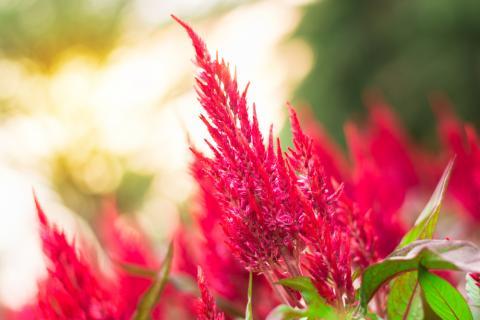
Cockscomb is a member of the family Amaranthaceae, also known as the Amaranth family of the genus Celosia L., commonly known as cock's comb P. The plant is said to be native to the dry slops of Africa and India, as well as the rocky regions of North and South America. Cockscomb (also spelled cock’s comb) is known by several names that include Celosia, Wool Flowers, and Brain Celosia. The flowers have no fragrance and bloom from late summer through early fall; they are primarily used as an ornamental flower in the garden and are an excellent cut flower for arrangements. The plant is grown as a cereal and leaf vegetable crop in southeast Asia and central and west Africa. The Nigerians use the leaves in recipes and call it “soko.” Cockscomb has long been used in Chinese medicine as a treatment for urinary tract infections, to stop bleeding, and heal blood diseases. The plant is easily grown either from seed or transplanting and grows well both outdoors in the garden or as a container plant.
Cockscomb grows in three main varieties that include blossoms of plumes, crests, or spikes with vivid colors of red, yellow, cream, orange, rose, deep magenta, and pink; there are some varieties that are bicolored. The blossoms are not made up of solid petals but consist of many small feather-like spikes that are not only soft to the touch but are quite hardy and are not affected by strong winds or storms. The plant can grow from a dwarf (six inches) to as tall as three feet.
How to grow cockscomb from seed
Cockscomb is a sub-tropical plant that needs the soil temperature to be at least sixty degrees Fahrenheit. In cold climates start seeds indoors four to six weeks before the last frost in peat pots. Plant about one-quarter inch deep and cover the pots with plastic wrap until the seeds germinate, then move the plants to a window with southern exposure. Keep the soil moist and spray with water that is room temperature and pinch off leaves that are not developing. After the last frost, introduce the plants to the outdoors by leaving them on the patio or porch for a few hours during the day in a protected area. Gradually increase the outdoor time; after a week they can be transplanted into the garden. Do not disturb the roots and do not plant them in rows. Be sure to cut off the peat pot to the soil top, then plant the pot ten inches apart for the smaller varieties and sixteen inches apart for the taller varieties. Keep them well watered.
How to purchase cockscomb plants
When purchasing cockscomb plants, look for the larger cell packs because they contain more soil and will protect the roots. Avoid purchasing plants whose roots are emerging from the bottom of the pack through the drain holes because they might be damaged by stress or root bound. The leaves should be well colored and free of insects. Also be sure that the soil is not dry. When transplanting, carefully push the plant out of the cell from the bottom and do not pull the plant from its stem. Place the plant in the ground at the same level it was growing in the cell pack, from ten to twelve inches apart, and keep the plant watered. Cockscomb does well in rich, well-drained areas.
Growing cockscomb in containers & indoors
Cockscombs do well as container plants and can be planted with other flowers that need similar growing conditions. It is best to plant all three types in one container, using the smaller growing varieties that will only reach two feet in height. The plants do well indoors and will show color within eight to ten weeks. It is recommended to use a color mix and be sure that they get eight to ten hours of direct sunlight.
Cockscomb as a healing herb
The entire plant has healing properties. The flowers control diarrhea and amenorrhea and are also beneficial in relieving dysentery, hemorrhoids, leucorrhoea, and uterine hemorrhaging. They are also used for ocular health.The leaves are used as a poultice for boils and sores. The seeds are used to ease chest pain and can be applied in a poultice to lessen the pain and hasten the healing of bone fractures. The plant extract in an alcohol solution also hastens the healing of burns and wounds.








